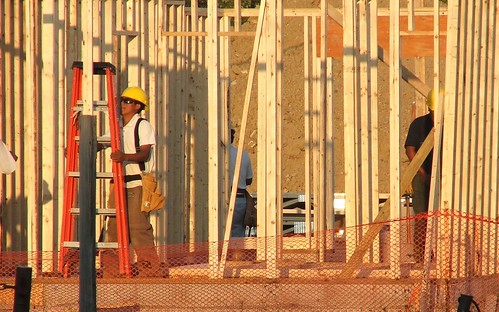 |
| Let’sDance, originally uploaded by brutal. |
Will California’s plans for reducing dangerous climate-changing emissions help or hinder the building and development market?
California’s most prominent association of real estate developers answered that question emphatically last week, saying that California’s law requiring regions to reduce emissions through smarter land use, transportation, and housing decisions is good for business.
California, through its still-new law SB 375, requires various state and regional agencies to take five actions SGA — and many readers of this blog — have been advocating for a long time.
- Create region-by-region targets for reducing greenhouse gases (GHGs),
- Develop land use and transportation plans to deliver these reductions.
- Ensure that actual transportation spending is consistent with these plans.
- Link these plans to plans for providing affordable housing.
- Streamline environmental review for projects that conform to these new regional plans.
(After Fulton)
Critics complain that this kind of planning will, by interfering with development, slow the economy and cost California jobs. The California District Councils of the Urban Land Institute, the nation’s largest association of developers, with an obvious interest in keeping development chugging along, came to the exact opposite conclusion:
The overarching anticipated benefit of SB 375 is its ability to provide more consistency, coordination, and clarity to the development process, which the land use industry needs to start recovering from the recession.
At the press conference releasing the report, Renata Simril, a VP with Forest City Development, said simply that SB 375 “is a pro-growth strategy.”
ULI anticipates a long list of economic, social, and environmental benefits from SB 375, and looks forward to aggressive implementation. “The better California does with SB 375 implementation, the greater the benefits will be,” ULI concludes.
Lessons for beyond California
ULI members look forward to aggressive SB 375 implementation for a mix of reasons, most of which apply outside California. SB 375 gets a lot of attention in part because its greenhouse gas reduction targets — and ULI again endorsed planning to reduce GHGs. But ULI is at least as interested in the economic benefits of good planning.
Broadly speaking, municipal service costs tend to increase with dispersed development outside existing urban boundaries, and are reduced with compact, planned development within existing urban boundaries. Substantial research finds that compact development produces a multitude of benefits: lower public financing, infrastructure development, and operating costs; improved economic performance; and improved fiscal performance for local municipalities. ULI also recognizes infrastructure expansion in existing urban areas can be more complex, more expensive, and more difficult to finance than conventional greenfield development, but the marginal increase in costs is outweighed by the long-term municipal savings generated over the life of the infrastructure. In other words, compact development can be fiscally positive.
These conclusions break no new ground, nor are they meant to. We know compact, planned development saves money, concludes ULI; let’s get going on it.
At the press conference releasing the report, several ULI developers pithily expanded on these and other themes. The video is well worth watching, and is available for 30 days here.